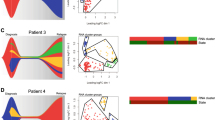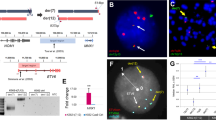Abstract
Acute myeloid leukemias (AMLs) result from a series of genetic events occurring in a stem or progenitor hematopoietic cell that gives rise to their clonal expansion and an impaired capacity to differentiate. To circumvent the genetic heterogeneity of AML patient cohorts, we have developed a model system, driven by the MLL-AF9 (MA9) oncogene, to generate multiple human leukemias using progenitor cells from a single healthy donor. Through stepwise RNA-sequencing data generated using this model and AML patients, we have identified consistent changes associated with MA9-driven leukemogenesis and demonstrate that no recurrent secondary mutations are required. We identify 39 biomarkers whose high expression level is specific to this genetic subtype of AML and validate that many of these have diagnostic utility. We further examined one biomarker, the receptor tyrosine kinase (RTK) RET, and show through shRNA knockdowns that its expression is essential for in vivo and in vitro growth of MA9-AML. These results highlight the value of novel human models of AML derived from single donors using specific oncogenic fusions to understand their biology and to uncover potential therapeutic targets.
This is a preview of subscription content, access via your institution
Access options
Subscribe to this journal
Receive 12 print issues and online access
$259.00 per year
only $21.58 per issue
Buy this article
- Purchase on Springer Link
- Instant access to full article PDF
Prices may be subject to local taxes which are calculated during checkout




Similar content being viewed by others
References
Cancer Genome Atlas Research N. Genomic and epigenomic landscapes of adult de novo acute myeloid leukemia. N Engl J Med 2013; 368: 2059–2074.
Lavallee VP, Baccelli I, Krosl J, Wilhelm B, Barabe F, Gendron P et al. The transcriptomic landscape and directed chemical interrogation of MLL-rearranged acute myeloid leukemias. Nat Genet 2015; 47: 1030–1037.
Kandoth C, McLellan MD, Vandin F, Ye K, Niu B, Lu C et al. Mutational landscape and significance across 12 major cancer types. Nature 2013; 502: 333–339.
Genomes Project C Genomes Project C Abecasis GR Genomes Project C Auton A Genomes Project C Brooks LD Genomes Project C DePristo MA Genomes Project C Durbin RM et al. An integrated map of genetic variation from 1,092 human genomes. Nature 2012; 491: 56–65.
Sunyaev S, Ramensky V, Koch I, Lathe W, Kondrashov AS, Bork P . Prediction of deleterious human alleles. Hum Mol Genet 2001; 10: 591–597.
Walter MJ, Payton JE, Ries RE, Shannon WD, Deshmukh H, Zhao Y et al. Acquired copy number alterations in adult acute myeloid leukemia genomes. Proc Natl Acad Sci USA 2009; 106: 12950–12955.
Valk PJ, Verhaak RG, Beijen MA, Erpelinck CA, Barjesteh van Waalwijk van Doorn-Khosrovani S, Boer JM et al. Prognostically useful gene-expression profiles in acute myeloid leukemia. N Engl J Med 2004; 350: 1617–1628.
Greaves MF, Maia AT, Wiemels JL, Ford AM . Leukemia in twins: lessons in natural history. Blood 2003; 102: 2321–2333.
Huret JL, Dessen P, Bernheim A . An atlas of chromosomes in hematological malignancies. Example: 11q23 and MLL partners. Leukemia 2001; 15: 987–989.
Zuber J, Radtke I, Pardee TS, Zhao Z, Rappaport AR, Luo W et al. Mouse models of human AML accurately predict chemotherapy response. Genes Dev 2009; 23: 877–889.
Barabe F, Kennedy JA, Hope KJ, Dick JE . Modeling the initiation and progression of human acute leukemia in mice. Science 2007; 316: 600–604.
Wei J, Wunderlich M, Fox C, Alvarez S, Cigudosa JC, Wilhelm JS et al. Microenvironment determines lineage fate in a human model of MLL-AF9 leukemia. Cancer Cell 2008; 13: 483–495.
Horton SJ, Jaques J, Woolthuis C, van Dijk J, Mesuraca M, Huls G et al. MLL-AF9-mediated immortalization of human hematopoietic cells along different lineages changes during ontogeny. Leukemia 2013; 27: 1116–1126.
Huang, da W, Sherman BT, Lempicki RA . Systematic and integrative analysis of large gene lists using DAVID bioinformatics resources. Nat Protoc 2009; 4: 44–57.
Barretina J, Caponigro G, Stransky N, Venkatesan K, Margolin AA, Kim S et al. The Cancer Cell Line Encyclopedia enables predictive modelling of anticancer drug sensitivity. Nature 2012; 483: 603–607.
Andersson A, Eden P, Lindgren D, Nilsson J, Lassen C, Heldrup J et al. Gene expression profiling of leukemic cell lines reveals conserved molecular signatures among subtypes with specific genetic aberrations. Leukemia 2005; 19: 1042–1050.
Watkins NA, Gusnanto A, de Bono B, De S, Miranda-Saavedra D, Hardie DL et al. A HaemAtlas: characterizing gene expression in differentiated human blood cells. Blood 2009; 113: e1–e9.
Yang W, Soares J, Greninger P, Edelman EJ, Lightfoot H, Forbes S et al. Genomics of Drug Sensitivity in Cancer (GDSC): a resource for therapeutic biomarker discovery in cancer cells. Nucleic Acids Res 2013; 41 (Database issue): D955–D961.
Salvatore G, Nagata S, Billaud M, Santoro M, Vecchio G, Pastan I . Generation and characterization of novel monoclonal antibodies to the Ret receptor tyrosine kinase. Biochem Biophys Res Commun 2002; 294: 813–817.
Ross ME, Mahfouz R, Onciu M, Liu HC, Zhou X, Song G et al. Gene expression profiling of pediatric acute myelogenous leukemia. Blood 2004; 104: 3679–3687.
Mullighan CG, Kennedy A, Zhou X, Radtke I, Phillips LA, Shurtleff SA et al. Pediatric acute myeloid leukemia with NPM1 mutations is characterized by a gene expression profile with dysregulated HOX gene expression distinct from MLL-rearranged leukemias. Leukemia 2007; 21: 2000–2009.
Mansky LM . Retrovirus mutation rates and their role in genetic variation. J Gen Virol 1998; 79 (Pt 6): 1337–1345.
Xiang Z, Zhao Y, Mitaksov V, Fremont DH, Kasai Y, Molitoris A et al. Identification of somatic JAK1 mutations in patients with acute myeloid leukemia. Blood 2008; 111: 4809–4812.
Mullighan CG, Zhang J, Harvey RC, Collins-Underwood JR, Schulman BA, Phillips LA et al. JAK mutations in high-risk childhood acute lymphoblastic leukemia. Proc Natl Acad Sci USA 2009; 106: 9414–9418.
Forster A, Pannell R, Drynan LF, McCormack M, Collins EC, Daser A et al. Engineering de novo reciprocal chromosomal translocations associated with Mll to replicate primary events of human cancer. Cancer Cell 2003; 3: 449–458.
Takeda A, Goolsby C, Yaseen NR . NUP98-HOXA9 induces long-term proliferation and blocks differentiation of primary human CD34+ hematopoietic cells. Cancer Res 2006; 66: 6628–6637.
Atanackovic D, Blum I, Cao Y, Wenzel S, Bartels K, Faltz C et al. Expression of cancer-testis antigens as possible targets for antigen-specific immunotherapy in head and neck squamous cell carcinoma. Cancer Biol Ther 2006; 5: 1218–1225.
Zang X, Thompson RH, Al-Ahmadie HA, Serio AM, Reuter VE, Eastham JA et al. B7-H3 and B7x are highly expressed in human prostate cancer and associated with disease spread and poor outcome. Proc Natl Acad Sci USA 2007; 104: 19458–19463.
Fonseca-Pereira D, Arroz-Madeira S, Rodrigues-Campos M, Barbosa IA, Domingues RG, Bento T et al. The neurotrophic factor receptor RET drives haematopoietic stem cell survival and function. Nature 2014; 514: 98–101.
Lavau C, Szilvassy SJ, Slany R, Cleary ML . Immortalization and leukemic transformation of a myelomonocytic precursor by retrovirally transduced HRX-ENL. EMBO J 1997; 16: 4226–4237.
Cozzio A, Passegue E, Ayton PM, Karsunky H, Cleary ML, Weissman IL . Similar MLL-associated leukemias arising from self-renewing stem cells and short-lived myeloid progenitors. Genes Dev 2003; 17: 3029–3035.
Krivtsov AV, Twomey D, Feng Z, Stubbs MC, Wang Y, Faber J et al. Transformation from committed progenitor to leukaemia stem cell initiated by MLL-AF9. Nature 2006; 442: 818–822.
Zeisig BB, Garcia-Cuellar MP, Winkler TH, Slany RK . The oncoprotein MLL-ENL disturbs hematopoietic lineage determination and transforms a biphenotypic lymphoid/myeloid cell. Oncogene 2003; 22: 1629–1637.
Corral J, Lavenir I, Impey H, Warren AJ, Forster A, Larson TA et al. An Mll-AF9 fusion gene made by homologous recombination causes acute leukemia in chimeric mice: a method to create fusion oncogenes. Cell 1996; 85: 853–861.
Dobson CL, Warren AJ, Pannell R, Forster A, Lavenir I, Corral J et al. The mll-AF9 gene fusion in mice controls myeloproliferation and specifies acute myeloid leukaemogenesis. EMBO J 1999; 18: 3564–3574.
Drynan LF, Pannell R, Forster A, Chan NM, Cano F, Daser A et al. Mll fusions generated by Cre-loxP-mediated de novo translocations can induce lineage reassignment in tumorigenesis. EMBO J 2005; 24: 3136–3146.
Figlioli G, Landi S, Romei C, Elisei R, Gemignani F . Medullary thyroid carcinoma (MTC) and RET proto-oncogene: mutation spectrum in the familial cases and a meta-analysis of studies on the sporadic form. Mutat Res 2013; 752: 36–44.
Ponder BA . The phenotypes associated with ret mutations in the multiple endocrine neoplasia type 2 syndrome. Cancer Res 1999; 59 (Suppl): 1736s–1741s; discussion 1742s.
Morandi A, Martin LA, Gao Q, Pancholi S, Mackay A, Robertson D et al. GDNF-RET signaling in ER-positive breast cancers is a key determinant of response and resistance to aromatase inhibitors. Cancer Res 2013; 73: 3783–3795.
Horio M, Kato T, Mii S, Enomoto A, Asai M, Asai N et al. Expression of RET finger protein predicts chemoresistance in epithelial ovarian cancer. Cancer Med 2012; 1: 218–229.
Gattei V, Celetti A, Cerrato A, Degan M, De Iuliis A, Rossi FM et al. Expression of the RET receptor tyrosine kinase and GDNFR-alpha in normal and leukemic human hematopoietic cells and stromal cells of the bone marrow microenvironment. Blood 1997; 89: 2925–2937.
Ibanez CF . Structure and physiology of the RET receptor tyrosine kinase. Cold Spring Harb Perspect Biol 2013; 5, pii: a009134.
Mostafavi S, Ray D, Warde-Farley D, Grouios C, Morris Q . GeneMANIA: a real-time multiple association network integration algorithm for predicting gene function. Genome Biol 2008; 9 (Suppl 1): S4.
Acknowledgements
This work was supported by grants from the Cole Foundation (to BTW, JH, MC—fellowship), the Fonds de Recherche du Québec en Santé (to BTW), Cancer Research Society (to BTW) and the Leukemia & Lymphoma Society of Canada (to FB) and CIHR (to FB). Human leukemia specimens were collected and analyzed by the Banque de cellules leucémiques du Québec (BCLQ), supported by the Cancer Research Network of the Fonds de Recherche du Québec en Santé (FRQS). We would like to thank the clinicians and nurses at CHU de Québec and Hotel Dieu de Lévis for cord blood collection and we also wish to acknowledge the contribution of all of the courageous patients who provided samples used in this study. We would like to acknowledge Josette-Renee Landry for critical comments on the manuscript and Marianne Arteau, Jennifer Huber, Raphaëlle Lambert and Danièle Gagné for expert technical assistance with experimental work.
Author contributions
BTW and FB designed the study, analyzed data and wrote the manuscript with help from LG, MC and AB. LG and AB engineered human leukemias in vivo from cord blood CD34+ cells. VL, ÉR, KL and AF were responsible for molecular biology work, cloning and cell culture work and RJ performed FACS analysis. ABP and EG generated the dual shRNA vector and tested these in cell lines with help from JP. JH and SC were responsible for banking of pediatric AML samples and JH analyzed cytogenetic studies of the human AML cells while JS, LP and SC isolated normal blood cell populations for RNA-seq. All authors discussed the results and participated in the revision of the manuscript.
Data deposition
All sequencing data has been deposited to GEO and is accessible through the following accession numbers: GSE71686, GSE71689, GSE70755, GSE71800, GSE71840, GSE72041 and GSE72061 within the GEO SuperSeries GSE71691. All whole-exome sequencing raw data were submitted to SRA database (SRA (http://trace.ncbi.nlm.nih.gov/Traces/sra/) accession number SRP062510).
Author information
Authors and Affiliations
Corresponding authors
Ethics declarations
Competing interests
The authors declare no conflict of interest.
Additional information
Supplementary Information accompanies this paper on the Leukemia website
Supplementary information
Rights and permissions
About this article
Cite this article
Barabé, F., Gil, L., Celton, M. et al. Modeling human MLL-AF9 translocated acute myeloid leukemia from single donors reveals RET as a potential therapeutic target. Leukemia 31, 1166–1176 (2017). https://doi.org/10.1038/leu.2016.302
Received:
Revised:
Accepted:
Published:
Issue Date:
DOI: https://doi.org/10.1038/leu.2016.302
This article is cited by
-
The biology of SCUBE
Journal of Biomedical Science (2023)
-
Effective drug treatment identified by in vivo screening in a transplantable patient-derived xenograft model of chronic myelomonocytic leukemia
Leukemia (2020)
-
RET-mediated autophagy suppression as targetable co-dependence in acute myeloid leukemia
Leukemia (2018)



